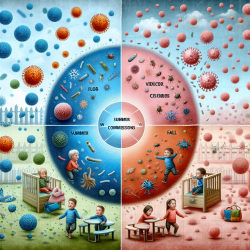Introduction
In the realm of speech-language pathology, understanding the environmental factors that influence child health is crucial. Recent research, such as the study on the "Seasonal dynamics of DNA and RNA viral bioaerosol communities in a daycare center," provides valuable insights into how viral communities fluctuate with seasons and human occupancy. This knowledge can be pivotal for practitioners aiming to enhance their therapeutic strategies and ensure healthier environments for children.
Research Overview
The study conducted a longitudinal analysis of the airborne DNA and RNA virome in a daycare center, revealing that both seasonality and human occupancy significantly influence viral community composition. Human-associated viruses were found to be more diverse and dominant during winter, while plant-associated viruses prevailed in summer. This highlights the dynamic nature of viral communities and their potential impact on child health in daycare settings.
Implications for Speech-Language Pathologists
Understanding these viral dynamics is essential for speech-language pathologists (SLPs) who work in or with daycare centers. Here are some key takeaways:
- Infection Control: Awareness of seasonal viral prevalence can guide SLPs in implementing effective infection control measures, especially during peak seasons of human-associated viruses.
- Therapeutic Environment: Creating a safe and healthy environment is crucial for effective therapy. Understanding the airborne viral load can help SLPs advocate for better ventilation and hygiene practices in daycare centers.
- Collaboration with Other Professionals: SLPs can collaborate with environmental health experts to monitor and mitigate viral exposure, ensuring that children receive therapy in a conducive environment.
Encouraging Further Research
While this study provides significant insights, it also opens avenues for further research. SLPs and researchers can explore:
- Impact on Speech and Language Development: Investigating how viral exposure affects speech and language development in children.
- Longitudinal Studies: Conducting multi-year studies to better understand the long-term effects of viral exposure on child health and development.
- Intervention Strategies: Developing targeted intervention strategies to minimize viral exposure and its potential impacts on therapy outcomes.
Conclusion
The study of airborne viral communities in daycare centers is a step towards understanding the complex interactions between the built environment and child health. For speech-language pathologists, leveraging this knowledge can lead to improved therapeutic outcomes and healthier environments for children. As we continue to explore the microbiome of our environments, it is essential to integrate these findings into practice and research.
To read the original research paper, please follow this link: Seasonal dynamics of DNA and RNA viral bioaerosol communities in a daycare center.










